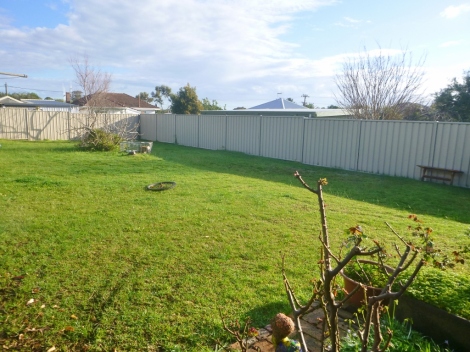
I’ve got a big grassy backyard to play with! I’m plotting all the fruit trees I can fit into it… and also trying to wait for a year before I make major changes, so I can observe every season. Observe and interact is the first principle of permaculture – before we design systems, we need to know what we’re working with.
Already, I’ve discovered I have a bit of a drainage problem under the house. It was like this for several weeks in winter. The lawn gets soggy in winter time. The water table rose to the same level as the grass. This also lasted for several weeks. And the gutters need redirecting. Some water tanks will help. I’ll still need an overflow solution, though. Like a raingarden or swales.
But I can’t refrain from planting out some of my pots. For one thing, they’ll be easier to water in the ground over summer. And plants are usually happier in the ground, with more soil life and less chance of drying out. The third permaculture principle is obtain a yield. So I put annual vegies in before I even owned the property. And I’m replacing some of the existing ornamentals with useful plants. ‘Use small and slow solutions‘ is another principle; this one means starting at the back door, and getting one garden area working well before starting the next one. A sensible idea for a working single parent.
I’m starting by planting the existing garden beds. This way I’ll have some food and medicinal plants this year without creating new structures, while I mull over the best design. I’ve put flowers, herbs and vines in the veranda gardens. The wooden bbq we picked up from the side of the road before we moved in. It’s my potting bench now. The black worm farm was sitting unloved at the farm. We haven’t put worms in it yet, but it’s ready to go.
The leeks I planted before the settlement went through are now close to picking size, and the broad beans are flowering. Notice I have left the delicious dandelion in the leek patch. Why pull out free, self-sown nutritious greens? The cos lettuce I planted is lush and large, and has been keeping us in lettuce for weeks. The butterheads are still small and stunted, even though it’s had the same conditions. Perhaps it needs warmer weather. I’ve also left some oxalis, or sourgrass, between the lettuce as it’s my son’s favourite snack.
I’ve pulled dead trees out of the large plastic pots that came with the house to plant fruit trees into instead. One now has a cumquat. I like eating cumquats, skin and all. I haven’t decided what to put in the other pots yet.
I planted a rose (Apricot Nectar) into the existing circle rose bed out the front. I took out the central ornamental and moved the bird bath to the middle. I discovered the phone line while I was digging the bird bath out – a good reminder to contact the Dial Before You Dig people. At least I know where one of the services is now! It survived unscathed. I also planted irises around the bird bath – not sure if they’ll get enough water there. And some garlic in a ring around the roses. 🙂
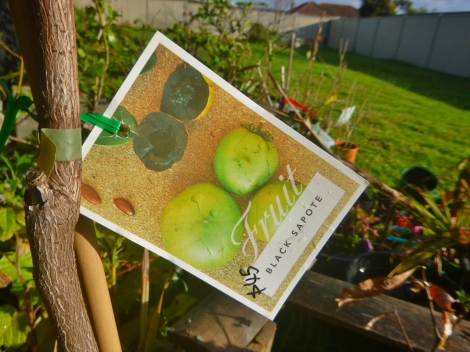
The first fruit tree to go in the ground is a black sapote, or Chocolate Pudding Fruit. Related to persimmons, it’s a soft dark sub-tropical fruit with big glossy leaves. I realised there was a space for one tree in the top garden bed against the fence. The neighbours have a wild patch of coprosma, or Mirror Bush, but this is on the south-west so it blocks the worst winter winds for me without shading my land. This part of my block is the highest, so it should be fine for trees that don’t like wet feet. It makes a nice sheltered spot, and the tree should grow up with plenty of sun.
There are a couple of beautiful old roses here, really in too much shade. I’m waiting to see how they do. I may move them later. Possibly the coprosma is providing an umbrella to them, and reducing fungal problems! I don’t have anywhere else prepared to plant them yet. They were really tall when I moved in, seeking sunlight; taller than me! I’ve pruned them down as far as I could (more trunks than stems!) as well as cutting the coprosma back around them.
I’ve got lots of land to plant, but I’d like an overall plan before I get stuck into it so I’m not changing things later. Also, it’s almost all grass and it’s easier to remove that first rather than mulch it and dig holes in the protective barrier to plant trees, where the grass will sneak back through. So I need to know the big picture.
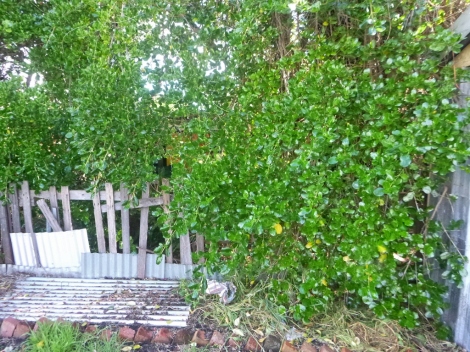
So it’s just the black sapote for now! There was a sheet of iron on the garden bed. Underneath, the soil was friable and weed-free. Yay! I handweeded the section next to it, pruned the rampant coprosma up a little, and had a whole strip ready to plant into. We planted:
Jostaberry, that I’d been carting from house to house in a grow-bag for years
Pineapple Sage, from cutting. I like brushing against the delicious-smelling foliage, and the flowers are pretty too; it’s good for tea, and attracts birds and insects.
Redcurrant, that has also been to several houses with me. This is how much it’s grown in less than a fortnight.
Pineberry runners, from a local gardener. These are a type of small, hardy, white strawberry with good flavour.
Raspberry, from my previous neighbour.
Yellow raspberry, from a local gardener. Cultivate those local networks!
Goji berry, looking scraggly but it might make it.
Loganberries, that I layered on the farm last winter. They’d only been in these pots for four months, and the roots had filled the space. I left them on the mother plant until I moved house, then I cut their umbilical cords and brought them with me.
Rose of sharon/hibiscus (not sure!), grown from cutting. One less pot plant to water over summer.
A daylily clump – the flower buds are edible.
Black anemone bulbs around the black sapote, bit late to plant them but will see how they go.
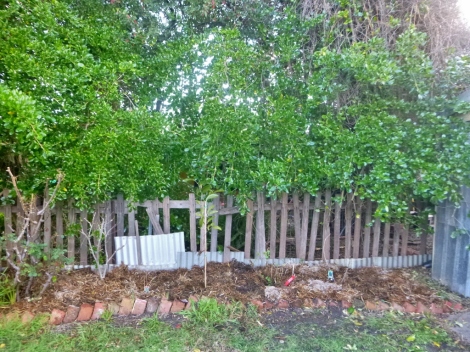
We mulched the lot with pea straw. This will keep the weeds down. The small fruits should cope with less sun. Yay! First tree in the ground! It looks a bit like a motley collection of sticks now, but it’ll all be leafing, blooming and fruiting soon as the weather warms up. The mixture of berry fruits means we should get food here this summer.
The idea of a food forest is to grow a multi-layered garden, including trees, shrubs, vines, herbs, groundcovers, fungi and bulbs. Some people also define a food forest as growing plants in deep mulch, like plants in a forest. It allows you to fit more food plants into a limited area, and it usually includes lots of perennials which are much less work than annuals. It’s a way of gardening that protects the microbial life in the soil, unlike conventional digging and chemical fertilising.
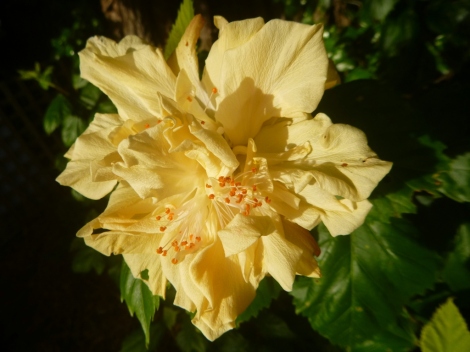
Years ago, I met Pat Ffyske Howden, who wrote ‘How To Live – Free At Last‘. It’s an enthusiastic book about small-scale solutions and homegrown technology. I liked it so much as a teenager that I photocopied most of the book from the library. You can download it for donation at the link above. He visited my rental home and I took him to a local LETS group. He tasted my hibiscus and mulberry leaves and told me I could put their young leaves in salads. His advice to me was grow more trees. Trees are much less labour than annual crops, and have much greater yield. Anything you can grow on a tree, switch to that, he told me. You can even get milk trees! I have a little hibiscus shrub here already – I’m glad, because I want to experiment with hibiscus hair recipes.
So I’m still on the path towards tree crops. I plan to plant out most of the backyard with edible trees, let chickens and ducks deal with the grass in two pens, and build raised beds close to the house for vegetables that are high enough for guinea pigs to free range underneath without being able to mow my parsley down. Guinea pigs are great mowers. At the moment, we have two in a cage but they prefer to free range.
I’m trying not to buy trees until next winter, so I don’t have to water them over summer. Unless I come across something particularly hard to find! For now, I’m just making lists and dreaming, and keeping everything else running. Coming up next – how to design a suburban permaculture property.






















Love your blogs – so informative and so great to follow along. Loved hearing about the milk tree and hibiscus hair care – thank you!
LikeLike
Pingback: Creating a Permaculture Base Map | Shoestring Sustainability·
Yay for choosing a chocolate pudding fruit as one of your first trees – that’s one of my favorite fruits. Also super cool that you’re thinking about milk trees. That’s such an obscure category of tree crops with tremendous potential. I look forward to hearing how your fruit plantings develop.
LikeLike
Thanks! It’s exciting to have the space to make some long-term plantings.
LikeLiked by 1 person
Pingback: How To Audit Your Bin | Shoestring Sustainability·
Pingback: A Year in a Suburban Backyard | Shoestring Sustainability·
Pingback: The Wonder of WWOOFers | Shoestring Sustainability·
Pingback: Covid 19: Crisis as Opportunity | Shoestring Sustainability·